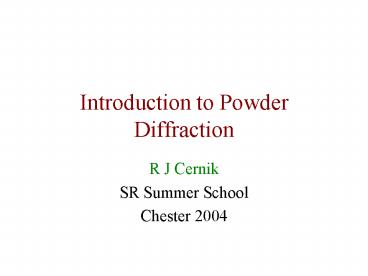Introduction to Powder Diffraction PowerPoint PPT Presentation
1 / 24
Title: Introduction to Powder Diffraction
1
Introduction to Powder Diffraction
- R J Cernik
- SR Summer School
- Chester 2004
2
Powder Diffraction
- Many hundreds of small crystallites
- Multiple, superimposed diffraction patterns
- Real materials
- Metals, alloys
- Minerals
- Drugs, pharmaceutical compounds
- Fuel cells, catalysts
- Cement and cementitious materials
3
(No Transcript)
4
(No Transcript)
5
(No Transcript)
6
(No Transcript)
7
(No Transcript)
8
Indexing
- The 2? values are directly measured
- We know ? Cu k? synchrotron Si calibration
- Braggs law 2d sin(?)n ?
- We know d for each reflection
- That is all we know
- With 80 to 200 reflections that is more than
enough to solve this miserable little problem
9
Wrong! But why?
D spacings Å
3.2
4.5
2.3
Could you re-construct the 3D structure just from
the d spacings written on the cards?
10
This is a problem in inductive reasoning, why is
it so difficult?
- The unit cell has up to 6 parameters or degrees
of freedom. Less for high symmetry materials.
Cubic cells are defined by one parameter,
orthorhombic cells 3 and monoclinic 4. - The maximum 6 parameters will use considerable
computing resources - You only need the cell constant a to generate a
cubic pattern. If this were reversible, an
unknown cubic cell could be found from a single
powder line, which is nonsense since its indices
wouldnt be known. - Instrumental function 2? zero and specimen
displacement add extra degrees of freedom - As 2? increases, the number of reflections also
increase as the third power. This quickly
overwhelms even synchrotron resolution, giving
overlaps that increase rapidly with 2?. Modern
pattern-decomposition methods help, but resolved
peaks remain more reliable than those extracted
from multiple overlaps.
11
More Problems
- Calculated Qhkl values depend on the second power
of their indices, becoming increasingly sensitive
with 2? to small cell changes. This helps cell
refinement, but not indexing, since the match of
each obs line to the nearest calc line becomes
unstable. So as 2? rises, assigned indices are
increasingly likely to be wrong, even if the cell
is roughly correct, which for least-squares
purposes is worse than not using those lines at
all. - Lines beyond the first 20 or 30 contribute little
indexing information, because they place few
constraints on possible cells. Thats why one
cant power through the degrees of freedom
problem simply by measuring more lines.
12
- By plotting figure-of-merit against lattice
parameters for an observed pattern, we can
explore its solution hyperspace, as shown in the
diagram.
13
- Method Space Exhaustive Status Program(s)
available - Zone indexing Parameter No Mature Yes (2)
- Successive dichotomy Parameter Yes Mature Yes
(1) - Grid search Parameter Yes Semi-mature Yes (1)
- Combined heuristic Parameter Semi Mature Yes
(2) - Genetic algorithms Parameter No Developing Yes
(1) - Simulated annealing Parameter No Not yet
tried No - Diffusion equation Parameter No Not yet
tried No - Scan/covariance Par. (both) To
monocl. Developing Yes (1) - Index heuristics Index No Mature Yes (2)
- Index permutation Index Yes Mature Yes (1)
- Shirley CCP14 ref
14
Decomposition
15
(No Transcript)
16
(No Transcript)
17
Decomposition
18
(No Transcript)
19
Rietveld refinement
20
(No Transcript)
21
(No Transcript)
22
(No Transcript)
23
(No Transcript)
24
(No Transcript)

